New Book Releases / Spring + Summer 2021
If you want to signal a recent or forthcoming film publication for the next round-up in fall, please contact Ruben Demasure. For notes on more books, see David Hudson’s monthly roundup at Criterion’s The Daily.
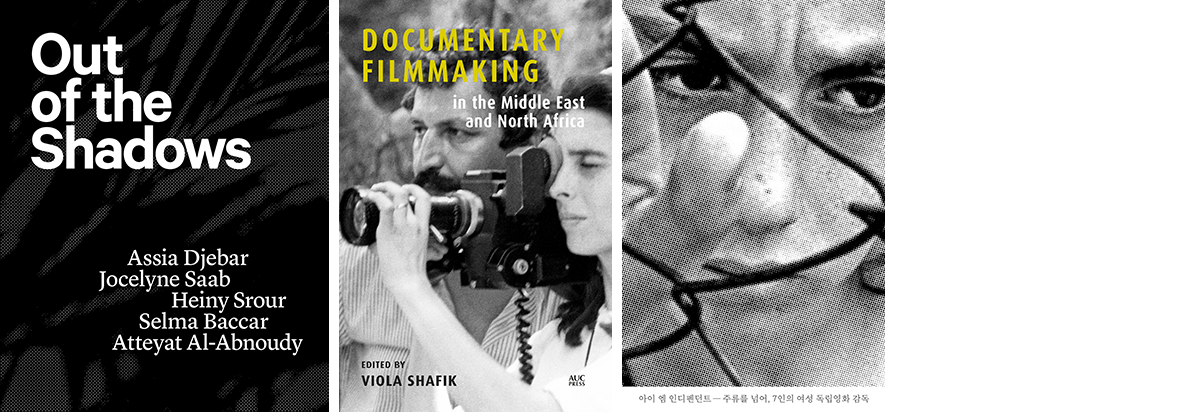
Allow us to open with a publication that Sabzian compiled, edited and published together with Courtisane festival and KASK School of Arts. Out of the Shadows focuses on five Arab female film directors whose work remains overlooked and barely screened: Atteyat Al-Abnoudy, Selma Baccar, Assia Djebar, Jocelyne Saab and Heiny Srour. The book brings together a selection of writings and interviews, most of which have been translated for the first time in English. Since the end of March, Sabzian has been systematically publishing the texts in its Out of the Shadows dossier. Originally conceived for the Courtisane festival 2020, the Out of the Shadows film program will now be presented at the festival this October. Courtisane made the publication available to read on Issuu. You can order a physical copy by sending an email to info@courtisane.be. Contributor, film historian and programmer Olivier Hadouchi has called it “un ouvrage appelé à devenir un livre de reference”, a publication bound to become a reference work. These five filmmakers from Egypt, Tunesia, Algeria and Lebanon will reappear in Documentary Filmmaking in the Middle East and North Africa, to which Hadouchi also contributed a chapter. Published by The American University in Cairo Press next month, this collected volume sets out to examine the long history of Arab nonfiction filmmaking in the Middle East and North Africa across a range of national trajectories and documentary styles, from the early twentieth century to the present.
Not five but seven women are the focus of I Am Independent - Beyond Mainstream: 7 Women Film Directors. This bilingual Korean/English book is published by the Jeonju International Film Festival and investigates seven figures that are pioneers in diverse ways and contexts: Cecilia Mangini, Forough Farrokhzad, Barbara Loden, Han Okhi, Anna Karina, Cheryl Dunne and Albertina Carri. The publication contains seven essays by seven women writers, each focusing on one of the filmmakers, plus a timeline of each director’s life. Contributors include Nicole Brenez, Devika Girish and Lucía Salas, among others. The festival will soon announce how the book can be ordered.
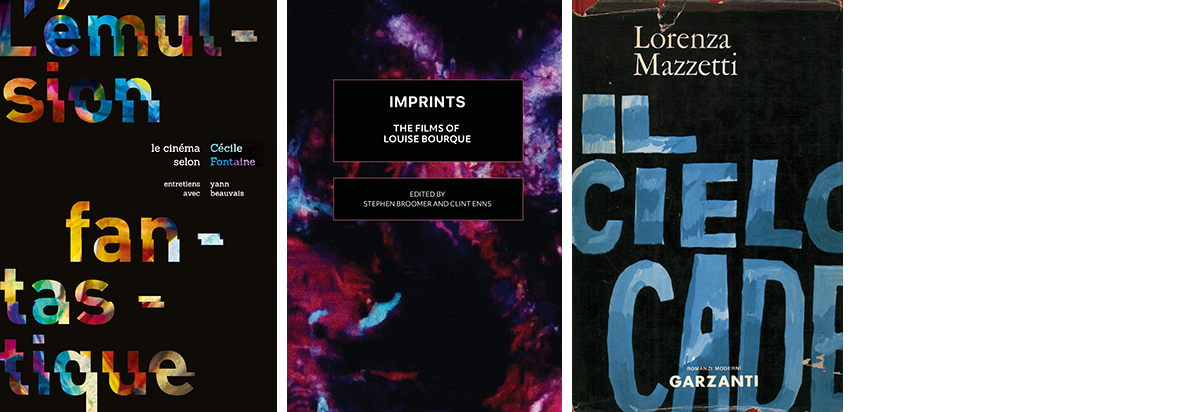
Two new monographs have been published on the work of two other female filmmakers: the French and French-Canadian experimental filmmakers Cécile Fontaine and Louise Bourque. L’Émulsion Fantastique: Le cinéma selon Cécile Fontaine includes two unpublished texts by Fontaine as well as a preface and an afterword by Yann Beauvais. Fontaine works the medium in a material sense, transforming its textures, colors and images by subjecting them to chemical reactions caused by various household products, creating new hybrid film objects through collage and recomposition, following motifs inspired by the original sources. You can order the book on the website of publisher Light Cone. Louise Bourque’s work also involves the physical manipulation of emulsion, in this case stemming from a different type of imprint, namely that of memory and trauma. Imprints: The Films of Louise Bourque is a collection of essays, interviews and personal reflections that chart her life and work. Contributors include Michael Sicinski, André Habib and Mike Hoolboom, with ephemera from Bruce Baillie, Robert Breer and Ken Jacobs, among others. This English-language book is published by the Canadian Film Institute and can be bought here.
Publishing untranslated and out-of-print texts by women filmmakers and critics, Another Gaze Editions will launch in December with a first book: The Falling Sky (Il cielo cade, 1961) by Lorenza Mazzetti in a translation by Livia Franchini. Mazzetti was an Italian filmmaker who became one of the founding members of the British Free Cinema movement. Her debut novel, Il cielo cade, is written in a narrative style of a child and describes the second world war from its point of view. Based on Mazzetti’s own traumatic childhood wartime experiences, the manuscript was rejected by several editors until Mazzetti sent it to Cesare Zavattini, the theoretician of Italian neorealism. It is now considered a classic of contemporary Italian literature and was admired by Federico Fellini and Henri Michaux. More information about the launch will be available on the website of Another Gaze.
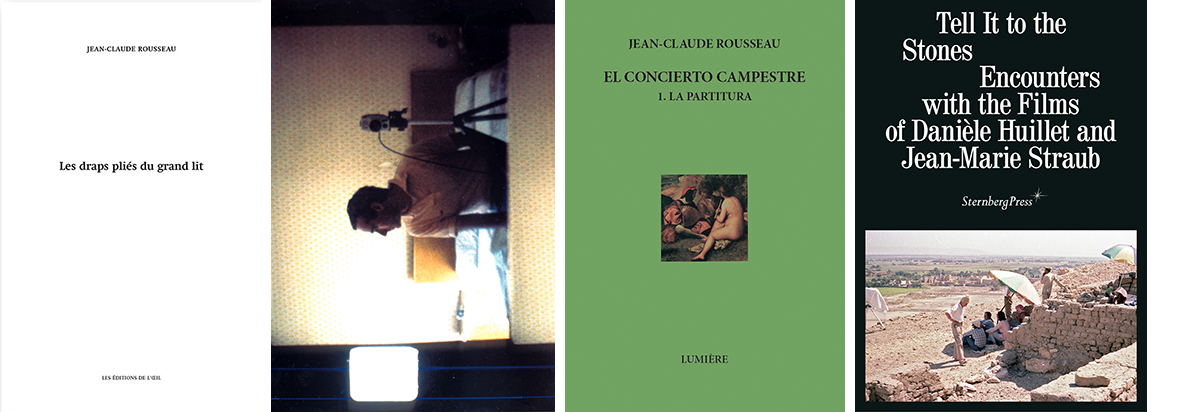
Earlier this year, a number of books have been published with and by the singular French filmmaker Jean-Claude Rousseau. Out since January, Les Draps pliés du grand lit is a collection of a series of Rousseau’s aphorisms, his “notes sur le cinématographe”, intimately written in direct correspondance with the films that he was beginning to guess. You can order this booklet on the website of publisher Les Editions de l’oeil. On the occasion of a cycle of screenings of his Super 8 films, Revista Lumière has released two print publications last February. La luz reflejada a través de las cosas is a new collection of interviews with Rousseau conducted by Francisco Algarín Navarro and Carlos Saldaña. Published shortly after Les Draps pliés du grand lit, they set out to understand what was behind those aphorisms. It’s based on 27 hours of interviews conducted in nine sessions in which they went through Rousseau’s beginnings in cinema, his reflections on the avant-garde film scene in the US and Paris in the 70s and 80s, the making of his five super 8 films, commented on one by one, and much more. They also discuss the genesis of what would have been his first film, Le concert champêtre. The second book, El concierto campestre, is a Spanish translation by Saldaña of the script for that unrealized film, originally published by Paris Expérimental in 2000. These twin publications are available for worldwide purchase on the website of Lumière.
The latter publication also includes various documents and manuscripts, as well as letters from Marcel Hanoun, Dominique Noguez or Jean-Marie Straub. Jean-Claude Rousseau was and is close with Jean-Marie Straub and Danièle Huillet. Forthcoming next month, Tell It to the Stones: Encounters with the Films of Danièle Huillet and Jean-Marie Straub presents a collection of artistic and intellectual responses to their filmmaking methods and body of work. Artists, writers, scholars (e.g. Barton Byg) and filmmakers (e.g. Peter Nestler and Louis Henderson), or long-time collaborators, such as cameraman Renato Berta, contribute new texts, revised transcripts, conceptual essays and visual montages – taking seriously what Huillet once requested from the audience: “to help us build the in-between”. You can find the full table of contents and order the publication on the website of publisher Sternberg Press.
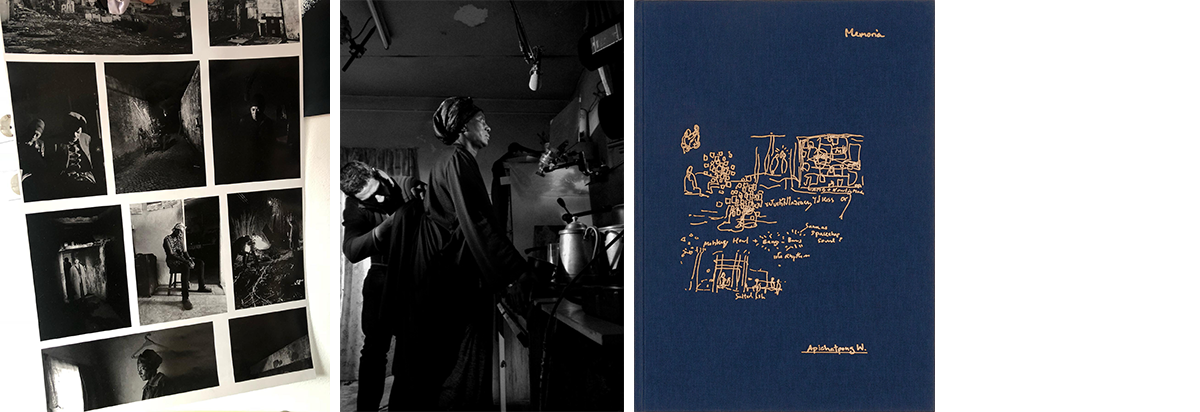
Next up are two production diaries. Vitalina Varela: Caderno de Rodagem collects images of different moments of the production and shoot of Vitalina Varela (2019) taken by filmmaker Pedro Costa and members of the crew in the suburbs of Lisbon and on the island of Santiago, Cape Verde, between 2017 and 2019. Together they present a visual record of Costa’s working methods. The book also includes a text on Vitalina’s life in English and Portuguese. You can pre-order the publication on the website of publisher Pierre von Kleist. It starts shipping this summer and all pre-orders will be signed by Pedro Costa.
Memoria is a chronicle of the genesis and creation of Apichatpong Weerasethakul’s new film of the same name, shot in Colombia. The book gathers the memories he collected, in the form of photographs, a personal diary and sketchbook, research notes, treatment excerpts, and email correspondence. These are placed alongside exclusive materials from the film’s production: set photographs, a diary of the shoot, annotated pages from the shooting script, storyboard panels, contributions from the cast and crew, and more. You can pre-order Memoria on the website of publisher Fireflies Press. Pre-orders will be mailed out after the Cannes premiere ahead of its September publication date.
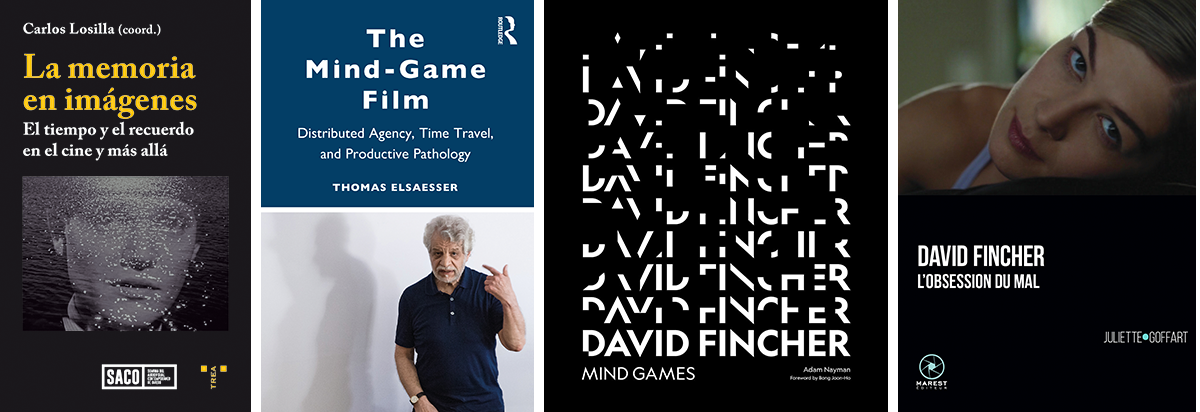
Another cluster of new film books also revolves around memory and the mind. La memoria en imágenes is a volume on time and memory in cinema, coordinated by professor and critic Carlos Losilla. Among the twelve chapters, there are contributions by Joe McElhaney and Charlotte Garson. The publication comes with a specially commissioned video essay by Cristina Álvarez López and Adrian Martin. You can buy this Spanish-language book on the website of publisher Trea.
Published last March, The Mind-Game Film is a posthumous collection of essays from Thomas Elsaesser. The publication gathers Elsaesser’s intense and passionate thinking about the Hollywood mind-game film from the previous two decades. You can find the table of contents and order the book on the website of publisher Routledge. Also written from this angle, Adam Nayman’s David Fincher: Mind Games is a survey of the director’s work. This thematically divided book is styled as an investigation into a filmmaker obsessed with investigation. Produced by Little White Lies, the book also includes original illustrations from the film magazine’s team of artists and graphic designers, alongside behind the scenes photography, still-frames, interviews with Fincher’s frequent collaborators, and a foreword by Bong Joon-ho. Forthcoming in November, the book can be pre-ordered on the website of publisher Abrams Books. In June, another book on David Fincher came out, David Fincher: L’Obsession du mal. Written in light of the question of evil in his work, Juliette Goffart explores his film and television work. You can order the book on the website of publisher Marest.
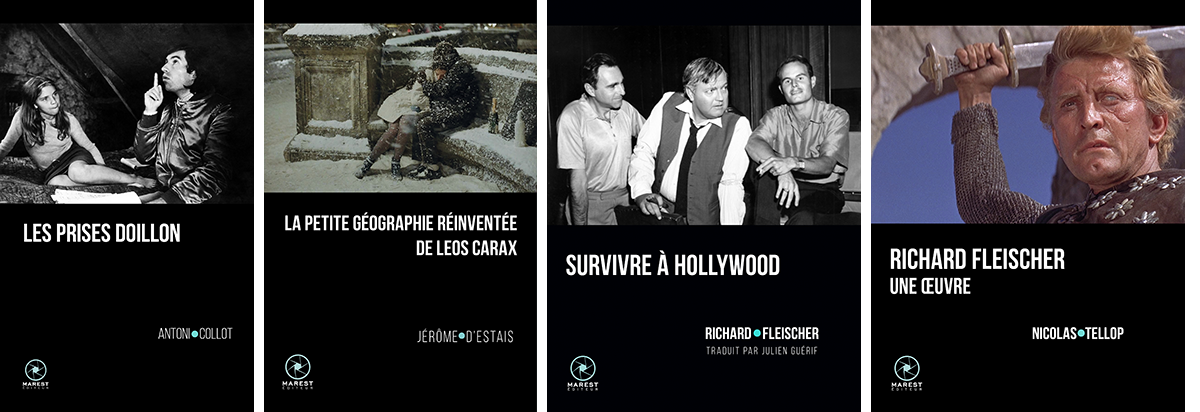
The Fincher book is just one of a wave of many new film books from the French publishing house Marest. Out since April, Les Prises Doillon is a theoretical essay on the work of Jacques Doillon. Published last month, La petite géographie réinventée de Leos Carax is a topographical and literary journey through the filmography of Leos Carax, by way of various recurring locations (the bedroom, the bridge, the limousine, the body of Denis Lavant, etc.). As his travelling guide, author Jérôme d’Estais chose Pierre Reverdy, whose poetry seems organically linked to the universe of Carax. In May, Marest also released twin publications around cult director Richard Fleischer, both supported by a successful crowdfunding campaign. Survivre à Hollywood is the first French translation of Fleischer’s memoirs, originally published in 1993 by Carroll & Graf as Just Tell me When to Cry. Fleischer sketches a sometimes sour, but often funny and enthusiastic portrait of his forty-five years in Hollywood – of its moguls, Disney, Hughes, Zanuck, and its stars, John Wayne, Robert Mitchum, Kirk Douglas, Juliette Greco and so on. This translation project is accompanied by a new monograph on the filmmaker by Nicolas Tellop. Richard Fleischer: Une œuvre is a richly illustrated essay that retraces the director’s career and demonstrates the consistency of his work. All of these books can be ordered on the website of the publisher.
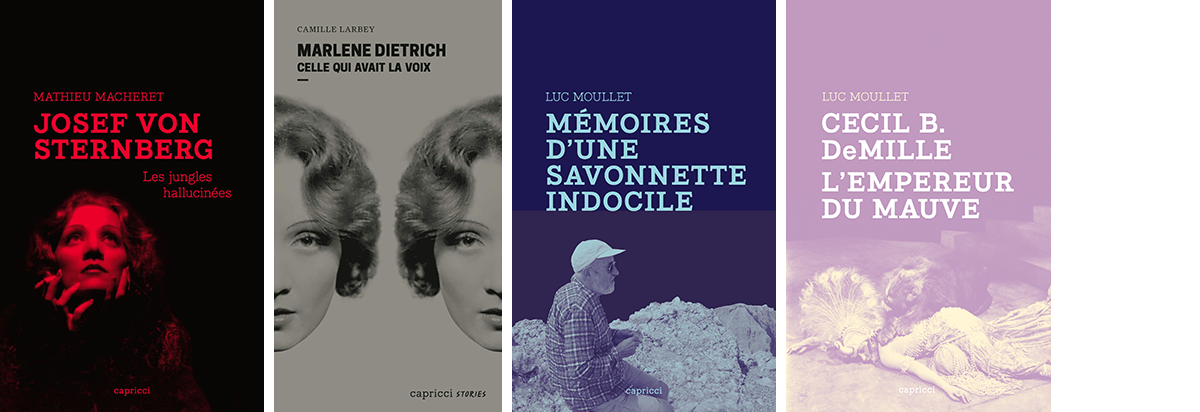
Just like Marest, the French publisher Capricci is on a roll. Last March, they put out a duo of books on filmmaker Josef von Sternberg and his fetish actress Marlene Dietrich. Mathieu Macheret’s Josef von Sternberg: Les jungles hallucinées is “an exercise in admiration for one of the most fiercely unusual and tragically sensual bodies of work ever to come out of Hollywood”, while Marlene Dietrich: Celle qui avait la voix focuses on the inimitable, suave and cajoling voice of the actress who claimed that her career only began with von Sternberg’s Der blaue Engel (1930), her first talkie. The publications are available on the publisher’s website, where you can also read an excerpt from both books. On the occasion of their retrospective of the work of Maurice Pialat that has started this month, Capricci will also publish a new booklength essay by Jérôme Momcilovic in September, Maurice Pialat: La main, les yeux (the cover isn’t available yet). In the meantime, Luc Moullet’s memoirs – already announced in our Spring 2020 book note – have been published by Capricci last month. This brings us to Srikanth Srinivasan’s new translation project of L’Empereur du mauve, Luc Moullet’s book on Cecil B. DeMille, originally published by Capricci in 2012. You can follow Srikanth’s English translation of Moullet’s 42 short chapters on his website, The Seventh Art.
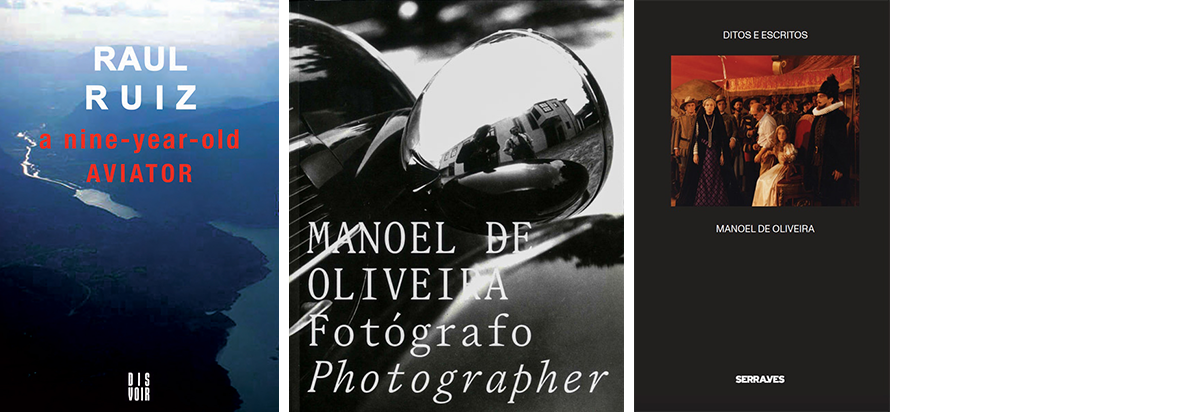
A previously unpublished story by Raul Ruiz has been discovered by his wife Valeria Sarmiento in a trunk. A Nine Year Old Aviator is one of a series of tales written in the 1970s for Sarmiento. As they were both living in exile in Paris and his wife was childminding to provide for them both, every day Ruiz would present her with a different story to read to the child she was looking after. This story has now been illustrated by Camila Mora-Scheihing, to whom this tale was read as a child. The book is available in French and English on the website of publisher Les presses du réel since January.
Another rediscovery can be found in Manoel de Oliveira: Fotógrafo / Photographer, a publication with photographs that belonged to the director’s personal collection – images, produced between the late 1930s and mid-1950s, that were kept for several decades but remained mostly unpublished. His activity as a photographer reveals a rather hidden facet of the filmmaker and opens new ways of looking at his cinematographic work. Also including essays by photography expert David Campany, among others, this bilingual book (EN/PT) can be ordered on the website of the Serralves Foundation that published it together with Casa do Cinema Manoel de Oliveira. Last month, these two institutions also released the first volume in their new Manoel de Oliveira Collection that will disseminate documents and notes from the filmmaker’s extensive archive. De Oliveira always pursued intense theoretical reflection for his film projects and with this collection they aim to reposition him amongst the group of leading theoretical-filmmakers of the twentieth century. Manoel de Oliveira: Sayings and Writings / Ditos e Escritos, available in a Portuguese and English edition, gathers speeches, interventions, annotations, letters, aphorisms and scattered writings, but also, for example, two rediscovered poems from 1986 that deal with his relationship with cinema. With almost 300 pages, the texts cover the entire trajectory of the filmmaker, from his film debut in the 1930s until his last shorts around 2014. According to António Preto, researcher and director of Casa do Cinema, the texts that de Oliveira wrote about each of his films will be collected in another volume.
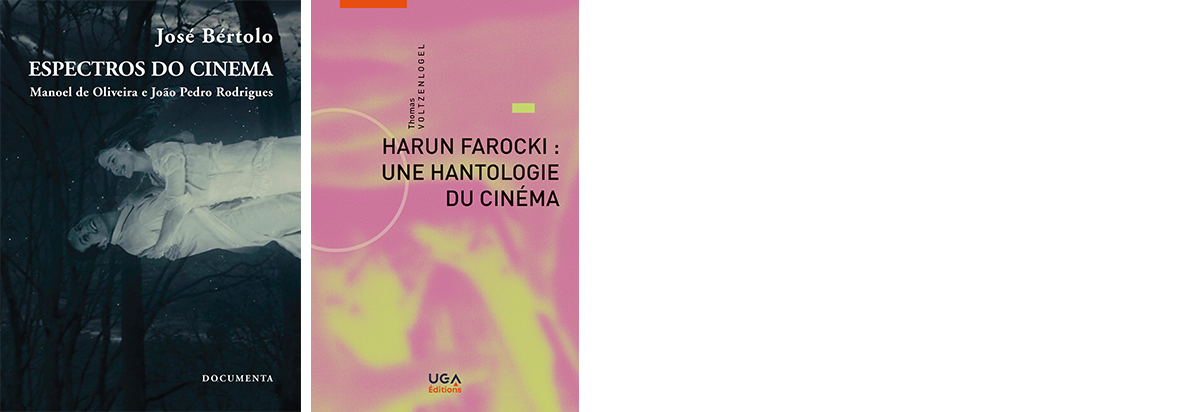
Another publication linked to the work of Manoel de Oliveira is José Bertolo’s Espectros do Cinema – Manoel de Oliveira e João Pedro Rodrigues, a “gallery of portraits of figures that, as they say in Benilde (de Oliveira, 1975), “are not of this world”, ghostly figures tied to a liminal existence that nevertheless find a form of wholeness in their ontological inconsistency". Here you can read the introduction, epilogue and table of contents. The book is actually one of three new publications by the Cinemateca Portuguesa, the other titles being Luis Miguel Cintra: O Cinema and A Coleção Colonial da Cinemateca. They are available through its bookshop Linha de Sombra.
Also adhering to the theme of the spectral is Thomas Voltzenlogel’s Harun Farocki: une hantologie du cinéma. The book aims to expand on the hauntological idea of cinema, traced by Jacques Derrida, stating that cinema is a ghostly affair, haunted by its own images. Something which is exemplified in the work of Harun Farocki, as Voltzenlogel suggests. For him the ultimate question is not how to read these haunting images, but how to live with them. This publication is the first in a new series of film books at the Université Grenoble Alpes, called “Cinéma, émergences-résurgences” and coordinated by Robert Bonamy and Didier Coureau. Since May, you can order the book on the website of UGA Éditions.
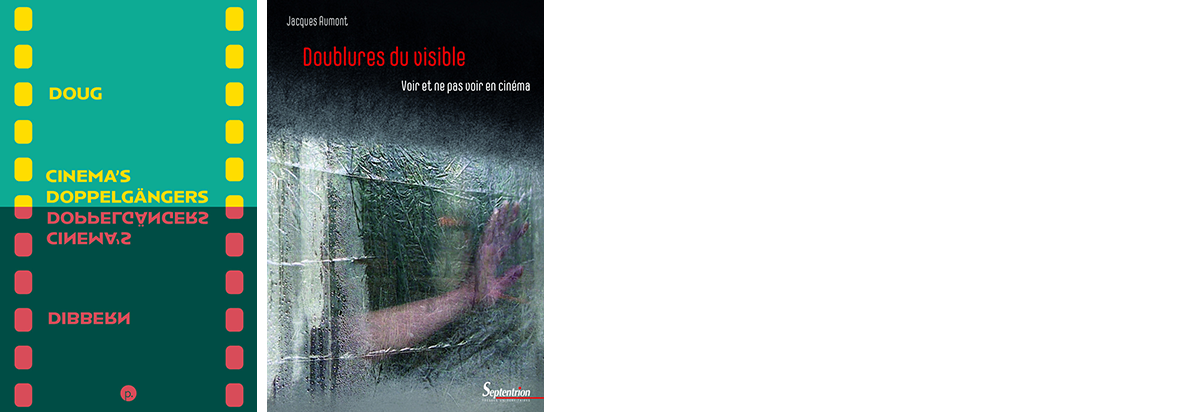
Not exactly a hauntology or spectral account, but a speculative counterfactual history of 20th century cinema has been undertaken by critic and scholar Doug Dibbern in Cinema’s Doppelgängers, published last month by Punctum Books. The book is a work of speculative fiction in the guise of a scholarly history of film and movie guide. That is, it’s a history of the movies written from an alternative unfolding of historical time – a world in which neither the Bolsheviks nor the Nazis came to power, and thus a world in which Sergei Eisenstein never made movies and German filmmakers like Fritz Lang never fled to Hollywood, a world in which the talkies were invented in 1936 rather than 1927, in which the French New Wave critics didn’t become filmmakers, and in which Hitchcock never came to Hollywood. Nevertheless, the book also aims to be a legitimate examination of the relationship between the economic and political organization of nations and film industries and the resulting aesthetics of film and thus of the dominant ideas and values of film scholarship and criticism. Dibbern analyzes movies you never thought you wanted to see, such as Godard’s Gangster Film (1998), Preminger’s Heimat (1960) or Orson Welles’ The United Nations (1974). Elena Gorfinkel finds the book “worth checking out for this table of contents alone”, and felllow critic Christopher Small called it “one of the best film books to come along in eons.” You can order a print copy or make a donation but the book’s also available to download as a free pdf e-book on the publisher’s website.
We could pair Cinema’s Doppelgängers with Quentin Tarantino’s much discussed novelization and counterfactual film history, Once Upon a Time in Hollywood: A Novel, that was published at the same time by Harper Perennial, or even with yet another double: Doublures du visible, the new book from critic and emeritus professor Jacques Aumont, published with Septentrion last April. Subtitled “Voir et ne pas voir en cinéma”, the publication looks at the large part of any film that remains invisible, while the historic role of cinema is to have given us the visible afresh, its “doublure” or duplication. It’s neither a theory nor history book and it avoids abstractions in favor of numerous concrete examples, from Ingmar Bergman’s 1963 Winter Light and The Silence, Vous n’avez encore rien vu (Alain Resnais, 2012), Viridiana (Luis Buñuel, 1961) or Hors Satan (Bruno Dumont, 2011), among others.
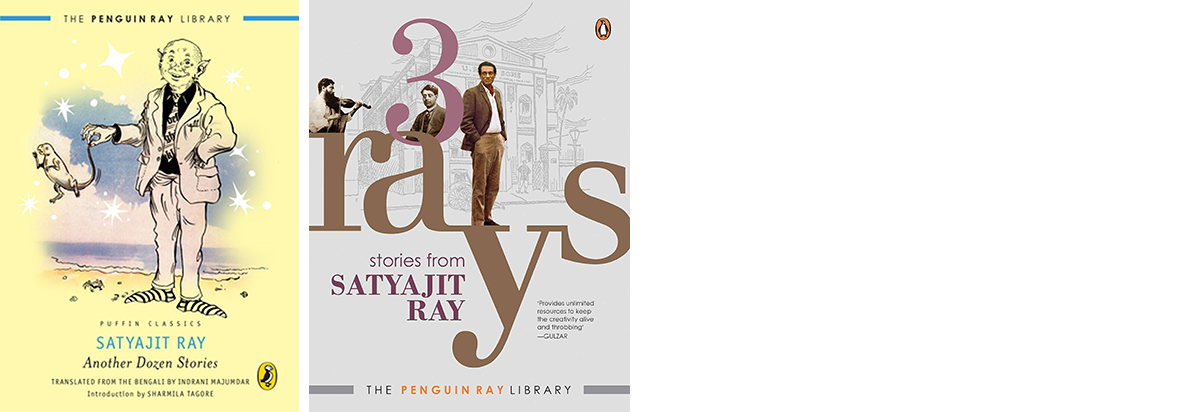
We’ve been celebrating the birth centenary of the Indian Bengali filmmaker Satyajit Ray on the 2nd of May this year. On this occasion, two books have been published by Penguin India that month. Translated from Bengali to English for the first time, Ray’s Another Dozen Stories is a collection of twelve magical, bizzare and spooky children’s stories, featuring Ray’s original artwork. The second book, 3 Rays: Stories from Satyajit Ray, collects his previously unpublished autobiographical writings, illustrations, fiction and non-fiction works, with more than forty stories and poems.
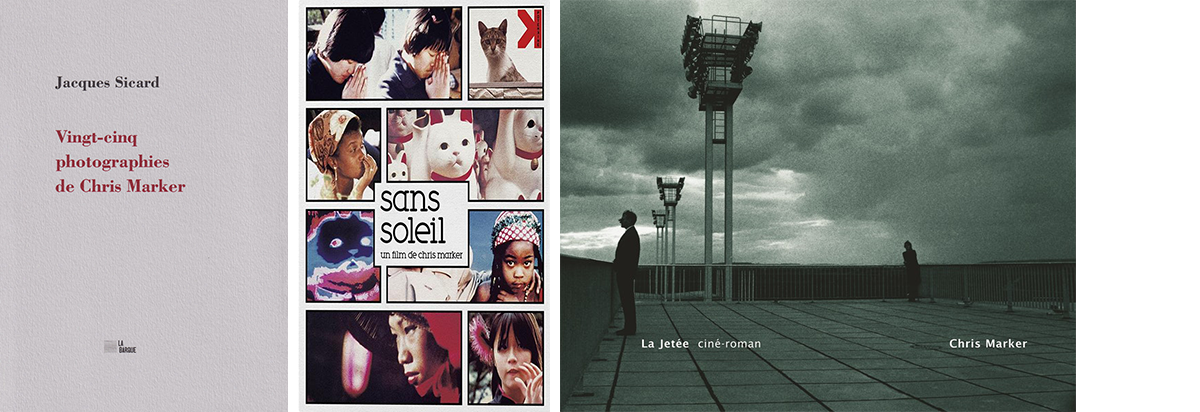
Another commemoration of a 100th birthday was that of Chris Marker on July 29. This also gave rise to a number of new publications. In Vingt-cinq photographies de Chris Marker, Jacques Jean Sicard selected 25 of the 800 still photographs out of which Marker’s 1966 film Si j’avais quatre dromadaires is entirely composed of. On each of them he wrote a short text, while none of the photographs are printed except for the one on the cover. Sicard is a writer and cinephile whose literary work is often inspired by the work of a filmmaker. Published last February, this 48-page booklet is available for purchase on the website of publisher La Barque.
Launched this May, the online resource Ecstatic Static also includes several books by Chris Marker in their expanding database of shared resources and information on artistic processes. Marker’s Commentaires (1967), Le Dépays (1982) or Coréennes (2009) are just a few of the books gathered in this splendid collection of freely accessible PDF resources that has been set up by Jason Evans and Myriam Schroeter. A reissue of the long out-of-print Le Dépays is also one of the things to be found in Potemkine’s new Blu-Ray collector's edition of Sans Soleil (1983) that contains a trove of extra’s and a 224-page book. At the beginning of the year, Potemkine had also released a collector’s edition of La Jetée (1962), including the 250-page cine-novel version of the film in large format.
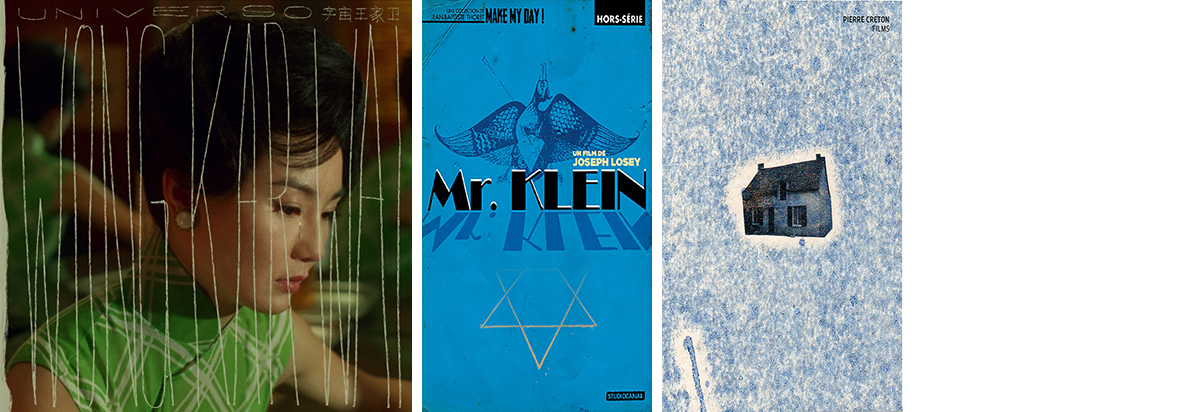
Other substantial DVD-books have recently been or will be published on the work of Wong Kar-Wai, Joseph Losey and Pierre Creton. Avalon released a limited edition Wong Kar Wai box set containing a 152-page book with Spanish texts by Carlos F. Heredero, film historian and director of the film magazine Caimán. After their DVD-book on Le Trou (Jacques Becker, 1960), Studiocanal releases a second “hors-serie” edition in the “Make My Day!” series run by critic Jean-Baptiste Thoret in September. This time, the restored film is Mr. Klein (Joseph Losey, 1976) and it will be accompanied by a 180-page book with texts by Thoret himself and Olivier Père, among others. A collection of three DVD-books brings together 21 films of the French filmmaker and farmer Pierre Creton, while each of the books include his other work, such as sculptures, drawings, photographs or collages, and texts by Cyril Neyrat, Gaëlle Obiégly and Mathilde Girard. N’Avons nous pas toujours été bienveillants? (gathering his work with Vincent Barré), Habiter and Sur la voie were published by Editions de l’Oeil together with La Traverse.
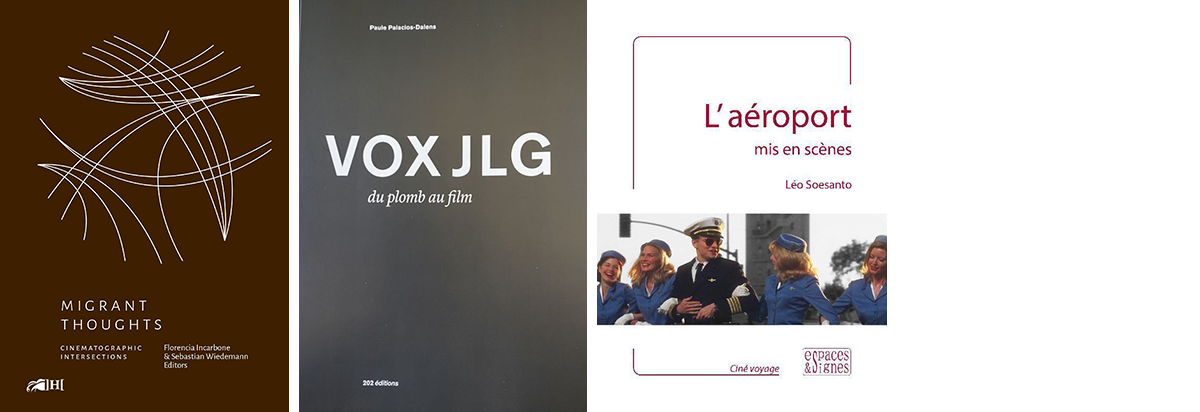
A next trio of books revolves around travelling images. Migrant Thoughts: Cinematographic Intersections presents a free collection of texts centered around the idea of the inevitably nomadic, migratory and omnipresent character of the image. “The image can of course move on the screen, but at the same time, the image makes a whole screen, a whole surface where it (...) continues in bodies, in writing, on these pages, as in politics, archives, memory, literature, and philosophy,” – categories that make up the three main “Intersections” of the book. Nicole Brenez and Yann Beauvais open and close this publication with an “Interval” contribution. Published last March, this English-language book can be downloaded for free on the website of the Buenos Aires-based platform and publisher Hambre | espacio cine experimental.
How images can travel between book and cinema or vice versa is what’s also at stake in VOX JLG: Du plomb au film. The book puts the work of Jean-Luc Godard in relation to that of the notable French publisher and typographer Maximilien Vox, who is his nephew. In her 2019 doctoral thesis on the typography and graphic design of Godard, author Paule Palacios-Dalens distinguished two main periods in his work by their typographical unity – the Antique Olive period, named after the typeface, and the Swiss period, named after his use of Helvetica and Univers typefaces – and sourced four key influences behind Godard’s savoir-faire, Maximilien Vox being one of them. Out since May, the book can be ordered on the website of publisher 202 éditions.
The third book takes travelling images quite literally. Published last March, L'aéroport mis en scènes explores cinema’s fascination with airports as loci dramatis. Making use of many film stills and even floor plans of the actual airport, French film critic and programmer Léo Soesanto looks into films of Jean-Luc Godard, Federico Fellini, Clint Eastwood, Jacques Tati and Chris Marker among others. On the website of publisher Espace et Signes, you can find the table of contents, two extracts and order the book.
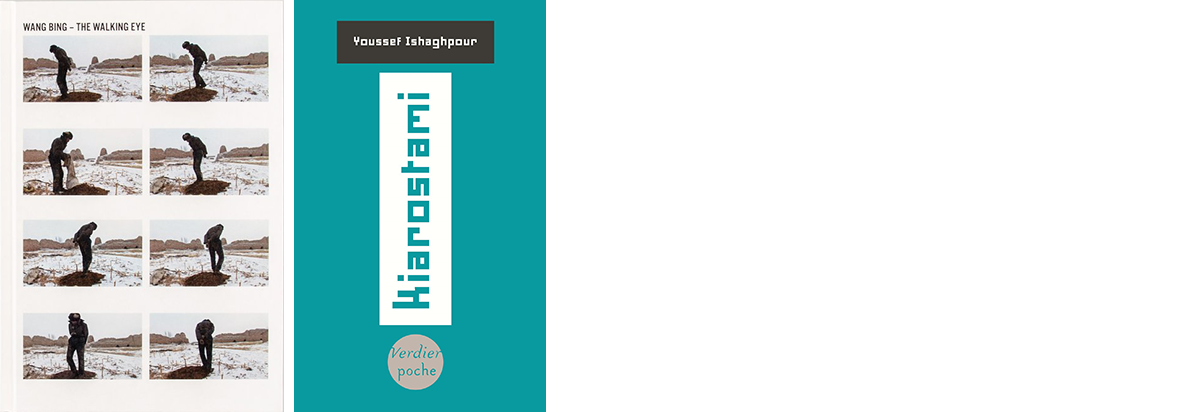
A number of exhibitions currently running in Paris are accompanied by new publications. LE BAL exhibits “L’œil qui marche”, an immersive installation by the Chinese documentary filmmaker Wang Bing. The eponymous book, edited by the exhibition’s curators Dominique Païni and Diane Dufour, aims to be the first reference work on the oeuvre of Wang Bing. Presenting 170 sequences from eight films made at the turn of the century (1999-2017), this voluminous book highlights the singularity of Wang Bing’s cinematographic language and the colossal and unprecedented scope of his anthropological project on the scale of a country-continent that has undergone a radical transformation. Co-edited by delpire & co (French version) and Roma Publication (English version), Wang Bing: The Walking Eye - L’œil qui marche is available in both languages on the website of LE BAL Books.
The Centre Pompidou’s exhibition on Abbas Kiarostami just ended this week. ‘Où est l’ami Kiarostami ?’ offered an unprecedented dive into the universe of the Iranian artist in all his dimensions: graphic works, photographic series, sequences from well-known and lesser-known films, experiments that defy artistic nomenclature... On the occasion of the exhibition, a new edition of Youssef Ishaghpour’s work on Kiarostami has been released. Published by Verdier, Kiarostami brings together the author’s two books on the filmmaker’s work – Kiarostami: Le réel face et pile and Kiarostami II: Dans et hors les murs – originally published in 2001 and 2012, respectively, and including a conversation with the director.
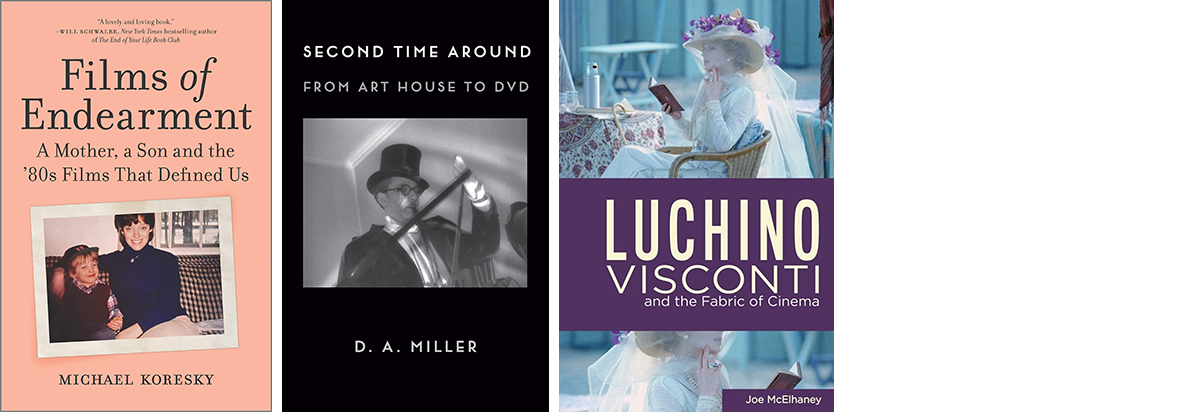
Another pair of new publications is concerned with looking back and revisiting films. Hanover Square Press recently published Films of Endearment: A Mother, a Son and the ’80s Films That Defined Us by Michael Koresky, cofounder and editor of Reverse Shot. The book, a follow-up to his 2014 study Terence Davies, blends a biographical account with critical analysis and film history. Throughout ten chapters, Koresky and his mother Leslie revisit a film from each year of the eighties that she showed him when he was growing up. It also became a reappraisal of the most important and popular female-driven films of that time. Koresky shared several excerpts (1, 2 and 3) from his book: “For me, the story of film is the story of a mother and a son, and both the fragile and unbreakable bonds that unite us.” Out with Columbia University Press, D.A. Miller’s Second Time Around: From Art House to DVD revisits films from the 60s and 70s. After discovering so many films via art houses and cinema clubs, Miller’s cinema memories should now be available at his fingertips through DVD and streaming. In his book, Miller reports on new viewings of the films he saw in the 1960s and 1970s, digitally restored work by directors ranging from Mizoguchi to Pasolini and from Hitchcock to Honda, looking to find not only what he first saw in them but also what he was then kept from seeing. One of the films Miller revisits is Luchino Visconti’s Rocco e i suoi fratelli (1960) and he also reviewed another new publication on its director, written by Joe McElhaney with Wayne State University Press. Through close readings of all his major films, Luchino Visconti and the Fabric of Cinema explores the recurrence of textiles, cloth and clothing in the cinema of Visconti. You can read an excerpt at Film International.
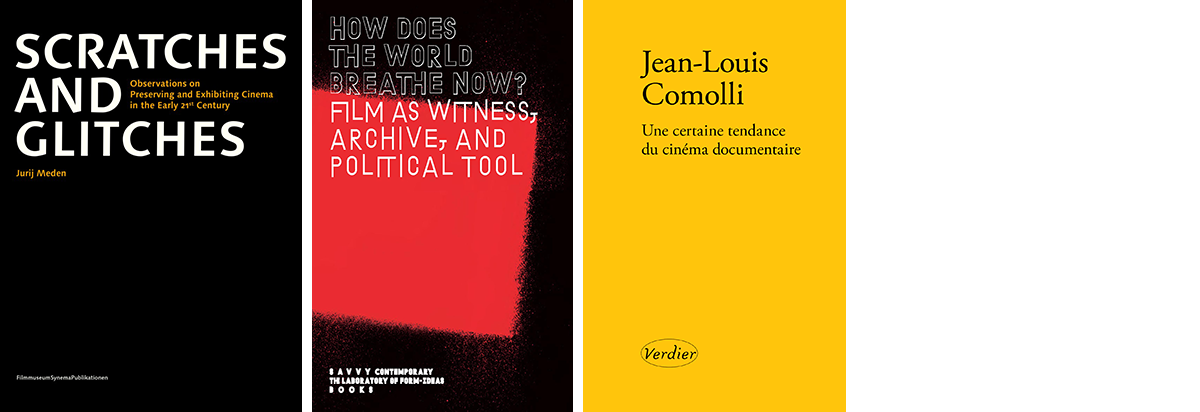
Two recently published books both look at the film archive, but from a somewhat different angle. Scratches and Glitches is a collection of short essays that attempts to make sense of the quick succession of changes that has drastically reshaped the domain of preserving and exhibiting cinema in the first two decades of the 21st century. Jurij Meden, curator at the Austrian Film Museum that publishes the book, does so by focusing on the wider context of cultural history and the responsibility of film archives and museums, guardians of film heritage. The website of the Austrian Film Museum links to the table of contents and an interview with the author by Light Industry and the museum itself. The second book, How does the world breathe now? Film as Witness, Archive and Political Tool, also includes a section on ‘Archiving, Preserving, and Accessing Film’ – the other two being on ‘New Relationships, New Practices: Towards Sustainable & Ethical Filmmaking’ and ‘Bearing Witness: Old & New Filmic Practices With Political Clout’. The publication grew out of a film series (2016-18) in which SAVVY Contemporary for over 52 weeks invited a different guest (artists, thinkers, activitst, poets, scientists, curators and other practitioners) who chose a film that they felt answered or examened the question “How does the world breathe now?”. This collection contains contributions by Sarah Maldoror and Olivier Marboeuf, among others. You can find the table of contents here, and order the work at the website of Archive Books that published it together with SAVVY Books.
In the way the latter book also “ponders how to form a more stable and supportive culture of film production and distribution,” the next publication is slighty related. Published with Verdier and written by critic and filmmaker Jean-Louis Comolli, Une certaine tendance du cinéma documentaire was instigated by the refusal of the author’s film Nicolas Philibert: hasard et nécessité (2019) for the Cinéma du Réel festival based on the grounds that it didn’t add anything “new”. Comolli’s documentary consists of a filmed conversation between him and Philibert, and in this booklet he defends and remembers documentary filmmaking as essentially a free form in which also the human body, its words and speech can find strength, beauty and dignity, “while the ‘tendency’ is to film situations, if not action”. Comolli discusses, in sixteen points, how, according to him, the institutions that initiate, shape or frame the production of documentary films (festivals, broadcasters, public funding, etc.) are stuck in a frenetic quest for “novelties”, while at the same time, they steer towards a certain tendency of conformism and standardization.
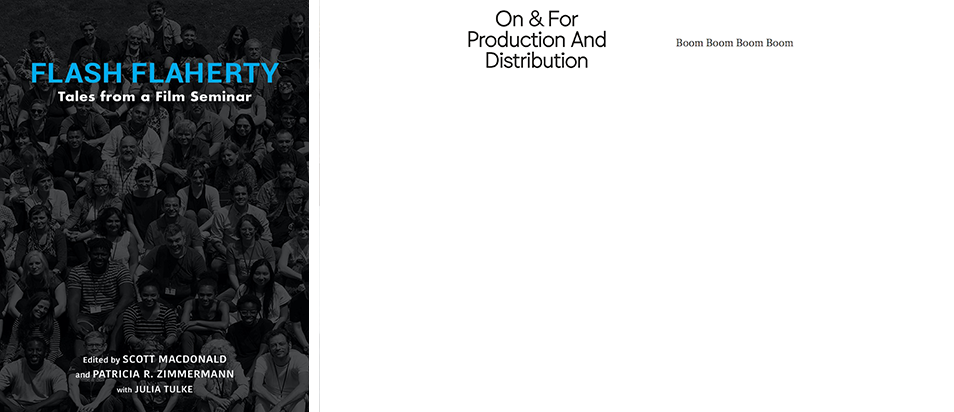
More from the documentary front: edited by Scott MacDonald and Patricia R. Zimmermann, Indiana University Press recently published Flash Flaherty: Tales from a Film Seminar, the follow-up volume to The Flaherty: Decades in the Cause of Independent Cinema. This collection offers a “people’s history” of the Robert Flaherty Film Seminar, the renowned seminar surrounding documentary forms and modes of the moving image. The book offers a mosaic of personal recollections from attendees of the Flaherty Seminar over a span of more than 60 years – among the contributors, you can find: Jonas Mekas, Bruce Jenkins, Lynne Sachs, Su Friedrich, Ken Jacobs, John Gianvito, Susana de Sousa Dias, Greg de Cuir Jr. and Anocha Suwichakornpong.
In a similar vein, On & For just released their second publication: On & For Production and Distribution (2018-2021), a printed memory of the project’s second edition. On & For is conceived to advance and strengthen the field of artists’ moving image (AMI), vitalising the networks of artists and professionals that work together in order to facilitate the production, distribution, commissioning, curating, and programming of AMI by bringing together the various professionals that nourish this field from all over Europe. Edited by Brussels-based visual artist, Sabzian member and On & For Project Coordinator, Rebecca Jane Arthur, and also including a contribution by Sabzian’s Nina de Vroome, this new publication gathers and reports three years of activity and translates it into writing and images (essays, drawings, photographs, interviews, facts and figures). A free digital pdf download of the full publication is available on their website, where you can also find how to get one of the 500 printed copies. Together with artist Eva Giolo, Rebecca Jane Arthur has a second publication out. Composed of letters, notes, anecdotes, translations, stills and images, BE GOOD IF YOU CAN’T BE GOOD BE GOOD AT IT Boom, Boom, Boom, Boom brings together their English/French correspondence on the act of writing and of filmmaking. Info on how to get one of the limited copies is available on the website of Elephy, the Brussels-based production and distribution platform they've co-founded with Chloë Delanghe and Christina Stuhlberger. Here you can read an excerpt.
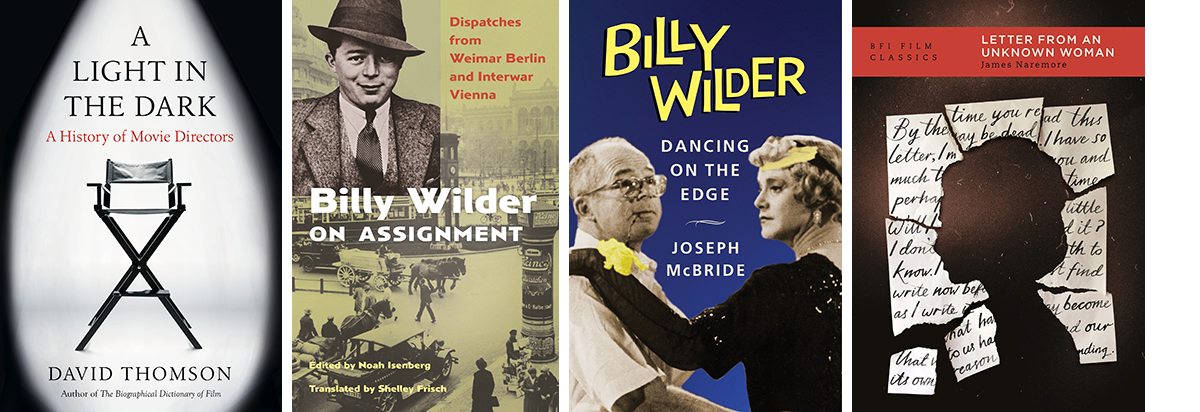
Last March, Knopf published David Thomson’s new book A Light in the Dark: A History of Movie Directors. Famed for The Biographical Dictionary of Film (Secker & Warburg, 1975; since 2014 in its 6th edition), Thomson offers 15 new essays, each personalized through a director. Although not limited to American filmmakers – he also spotlights Godard, Renoir, Bunuel or Lang – the book is focused on US directors such as Kubrick, Hawks, Hitchcock, Welles or Nick Ray, and contains a chapter on “the American auteur”. This leads us to a round of monographic studies on American filmmakers. Two new books on Billy Wilder have been or will be published. Before Billy Wilder became the acclaimed writer-director, he worked as a freelance reporter, first in Vienna and then in Weimar Berlin. Out with Princeton University Press, Billy Wilder on Assignment brings together more than fifty articles – a mix of cultural essays, interviews, and reviews, translated into English for the first time – that Wilder (then known as “Billie”) published in magazines and newspapers between September 1925 and November 1930. Among the pieces, one can read his appreciations of such figures as Asta Nielsen, Erich von Stroheim or Charlie Chaplin. In Billy Wilder: Dancing on the Edge, Joseph McBride also returns to the filmmaker’s background in the Austro-Hungarian Empire and work as a journalist in Berlin. Mixing biographical insight with in-depth analysis of films from throughout Wilder’s career, and drawing on the author’s own interviews with the director and his collaborators, this critical study reveals Wilder to be a disappointed romantic rather than the hardened cynic he’s generally believed to be. The book is forthcoming in October with Columbia University Press. McBride is a film critic and professor who’s written acclaimed biographies of Ernst Lubitsch, John Ford, Frank Capra and other masters. Because this book is rich with information about the Viennese/Weimar culture, film critic and emeritus professor James Naremore called it an ideal companion to McBride’s recent How Did Lubitsch Do It? that got a paperback edition last year. Naremore’s own monograph on Letter from an Unknown Woman (Max Ophuls, 1948) is by the way one of the nine new additions in the BFI Classics series this spring.
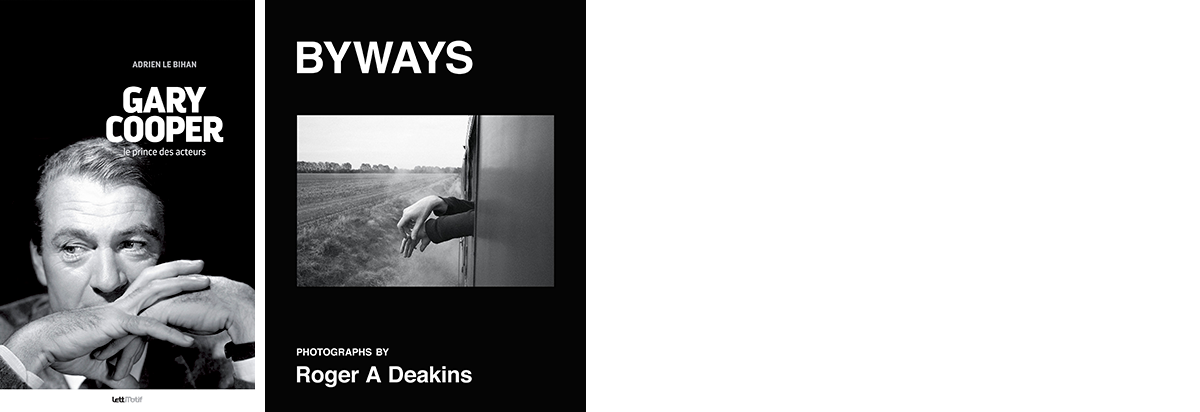
An actor for both Lubitsch (Design for Living, Bluebeard’s Eighth Wife) and Wilder (Love in the Afternoon), Gary Cooper is celebrated in a new biography, the first to appear in France since 40 years. Published by Editions LettMotif last April, Gary Cooper: Le prince des acteurs goes into the actor’s wide range of genres and his natural style, arguing that if Clark Gable was “the King of Hollywood” and John Wayne “Duke”, then Cooper finally deserves the title of “Prince”. Meanwile, “Sir” Roger Deakins – the distinguished and popular cinematographer best known for his work in Hollywood with the Coen brothers, Sam Mendes and Denis Villeneuve – will publish a first monograph of his rarely shown still photography next month. Forthcoming with the Italian art book publisher Damiani, Byways includes previously unpublished black-and-white photographs spanning five decades, from 1971 to the present.
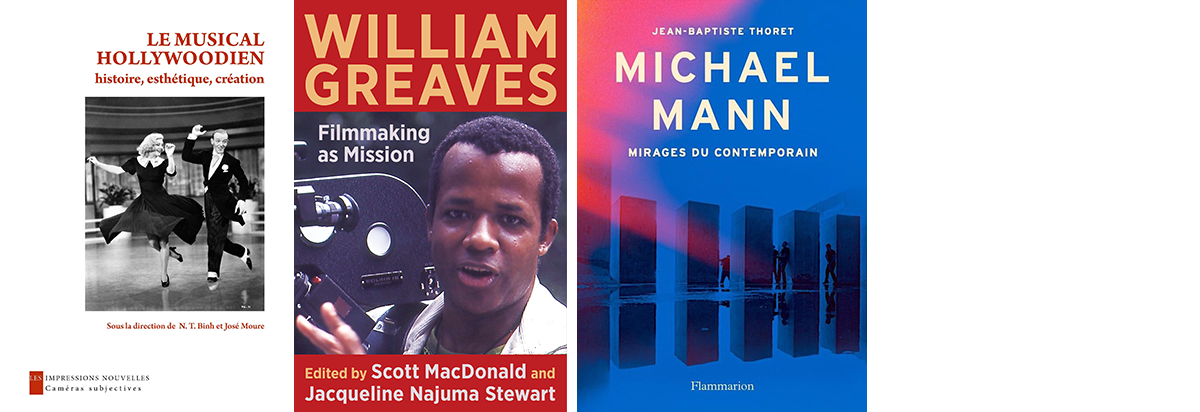
Although a collection on the genre, Le Musical hollywoodien: Histoire, esthétique, création also singles out certain filmmakers, films or actors through its chapters, such as Busky Berkely, Fred Astaire, Gene Kelly, Vincente Minnelli or Frank Sinatra, and closes with an unpublished interview of Rui Nogueira with Ginger Rogers. This almost 500-page reference work brings together specialists of the classic Hollywood musical and is one of three new film books published by Les Impressions Nouvelles this Spring, the other ones being L’Atelier du scénariste: Vingt secrets de fabrication and Un cinéma en quête de poésie.
Published last June by Columbia University Press, William Greaves: Filmmaking as Mission provides the first comprehensive overview of the remarkable career of William Greaves, the multitalented artist and influential independent documentary filmmaker who produced, directed, shot, and edited more than a hundred films on a variety of social issues and on key African American figures. Edited by Scott MacDonald and Jacqueline Najuma Stewart, this volume brings together a wide range of material, including a mix of incisive essays from critics and scholars, Greaves’s own writings, an extensive meta-interview with Greaves, conversations with his wife and collaborator Louise Archambault Greaves and his son David, and a critical dossier on his best known film Symbiopsychotaxiplasm: Take One (1968). Together, they illuminate Greaves’s mission to use filmmaking as a tool for transforming the ways African Americans were perceived by others and the ways they saw themselves.
A final monographic study on a singular American filmmaker is Jean-Baptiste Thoret’s Michael Mann: Mirages du contemporain, which is forthcoming in September with Editions Flammarion. Initially scheduled for 2015, this long-awaited monograph retraces the career and work of Hollywood director Michael Mann, his invention of the tinselly aesthetics of the 1980s and position at the crossroads of experimentation and popular cinema, but also the television work he always returned to. His aerial and contemplative way of filming suggests a vision of the contemporary world that combines fascination and melancholy. How do his films document our time? Each of Mann’s films focuses on economic, political or technological changes which his characters seem to control despite themselves. What are these mirages of the contemporary that render his cinema sensible?
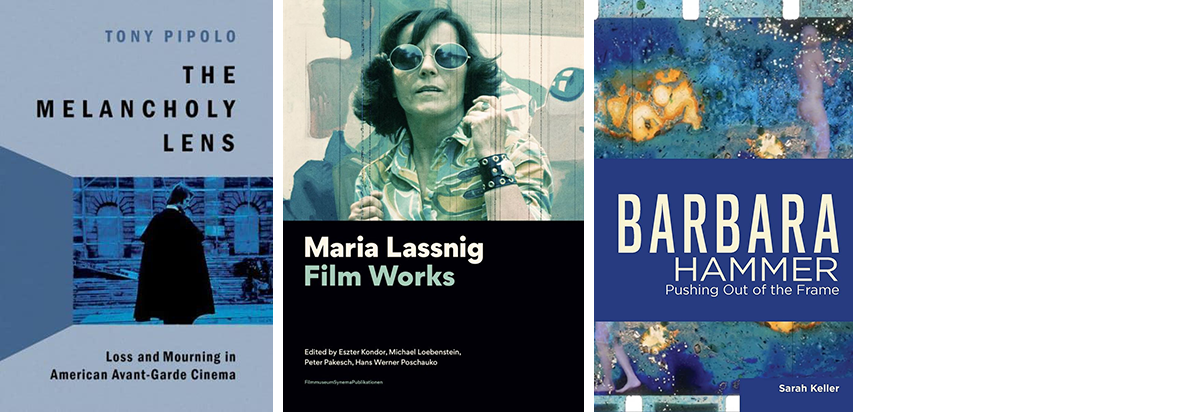
In that connection, there’s also a trio of new publications on and by the US avant-garde. Published by Oxford University Press, The Melancholy Lens: Loss and Mourning in American Avant-Garde Cinema offers a detailed look at the significant role of underlying biographical and psychological factors of loss, mourning and charged parental relationships in specific works by leading avant-garde filmmakers, including Maya Deren, Stan Brakhage, Gregory Markopoulos, Robert Beavers, Ken Jacobs, and Ernie Gehr. In his afterword, film writer and Professor Emeritus Tony Pipolo considers later figures whose work is kindred to the theme of this book, among them Nathaniel Dorsky, Phil Solomon, David Gatten, and Lewis Klahr. Another figure of the US-American film avant-garde of the 1970s, the acclaimed painter Maria Lassnig (1919-2014), is celebrated in a new publication by the Austrian Film Museum. Maria Lassnig: Film Works, provides the first comprehensive index of her film works. Published in both an English and a German version, the book offers insight into the filmmaker’s world of ideas through a wide selection of Lassnig’s own previously unpublished notes along with conversations on the rediscovery and 2018 restoration of her films. It also encloses a selection of Lassnig’s “films in progress” on DVD. The career of a female filmmaker of the American avant-garde who also began in the early 70s is explored in Barbara Hammer: Pushing Out of the Frame. In this monograph that’s forthcoming next month with Wayne State University Press, Sarah Keller, who previously published books on Jean Epstein, Maya Deren and cinephilia, studies the life and work of this pioneer of queer and politically feminist experimental cinema and visual art. In a final chapter, excerpts from the author’s interviews with Barbara Hammer during the last three years of her life offer intimate perspectives and reflections on her work from the filmmaker herself.
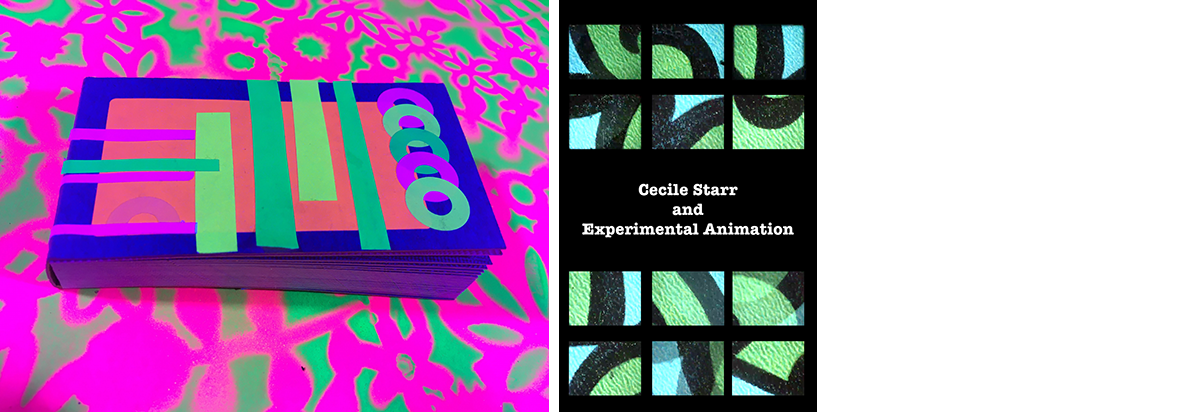
The playful and imaginative contemporary US avant-garde filmmaker, Jodie Mack, has made a series of flipbooks, published by Infinite Kisses, a new collective platform showcasing zines, artists books and multiples. Ultraviolet is an animated flipbook that delves into the nuanced relationship of glow-in-the-dark, neon, and fluorescent entities within analog and computational photography, printmaking, and digital imagery. Fusing together previous interests in printed materials and textiles, Ultraviolet brings to the surface many of the complications around original and technological replica. Unfortunately, this limited edition of 150 books seems out of stock by now. Including an introductory personal reflection by Jodie Mack, Cecile Starr and Experimental Animation is dedicated to the writer, educator, curator, and film distributor that was a key influence on Mack, who’s made work directly inspired by Cecile Starr. Published by Paris Expérimental and Eyewash Books, this English-language publication includes Starr’s contributions to Experimental Animation – her best-known book and the first major survey of its subject, co-authored with Robert Russett and originally published in 1976 – as well as a collection of her other writing on the historical roots of avant-garde film.
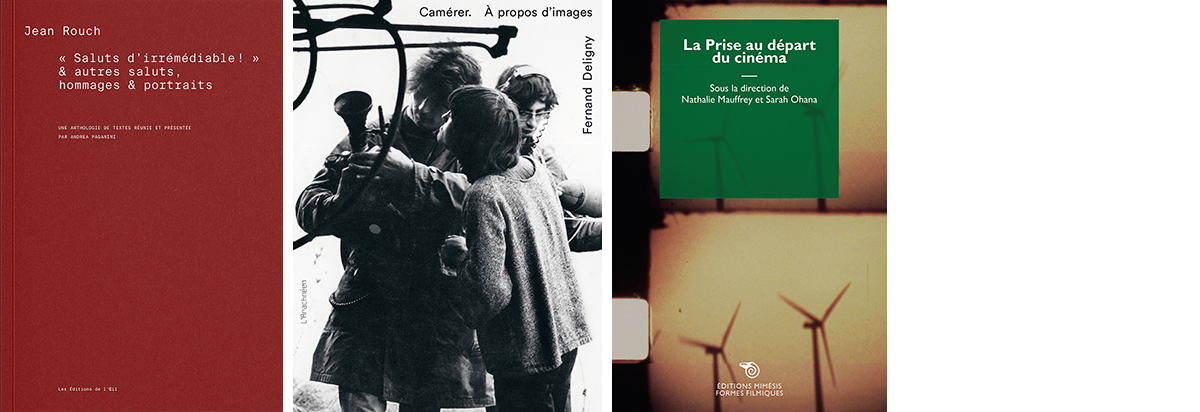
Another batch of eight new publications is coming from France and/or focuses on French filmmakers. Published in May by Les Éditions de l’oeil, Jean Rouch: “Saluts d’irrémédiable!” & autres saluts, hommages & portraits is an anthology of texts, written or spoken by Jean Rouch for people he has known and loved. Together, these texts form as many portraits of relatives, friends, travel and work companions, and snapshots of their journeys in the fields of cinema and anthropology. These writings, several unpublished, are gathered for the first time by Rouch specialist Andrea Paganini and make it possible to highlight, not only a kind of self-portrait of the author, but also certain less commented aspects of his work, and first of all the beautiful art of portraiture and the sensitive practice of homage and admiration along a trajectory as long and rich as that of Jean Rouch. Among the remarkable list of dedicatees, one can find: Ousmane Sembène, Joris Ivens, Dziga Vertov, Georges Sadoul, Jean Epstein, Jean Painlevé, Alberto Cavalcanti, Roberto Rossellini, François Truffaut, Manoel de Oliveira, Néstor Almendros, Michel Simon, Henri Langlois, Jacques Ledoux, and Luc de Heusch.
Éditions L’Arachnéen continue their impressive work on the archive and writing and thinking of the singular educator and filmmaker Fernand Deligny with a new publication, Camérer: A propos d’images. This book is not a book on cinema, nor an essay on the phenomenology or aesthetics of the image, but all of this at the same time, and something else, coming from a writer in close contact with the perception of children with autism. The basis of the book is a corpus of unpublished texts on the image that were recently extracted from two large trunks of loose manuscripts by Deligny. Questioning cinema, both as a word and a practice, these texts focus on the vast world of images which Deligny tries to make sense of with and against language. You can also find a chapter by Stéphane Privat on Fernand Deligny and his neologism/practice/gesture of ‘camérer’, which he preferred to ‘filming’, in the new collection La prise au départ du cinéma. Edited by Nathalie Mauffrey and Sarah Ohana and out with Editions Mimésis, the book focuses on the film take as a gesture, technique and concept from a multitude of approaches and perspectives: experimental, cinematographic, institutional, psychological, political, ethical and poetical. One of the cases is Robert Kramer's shooting of Route One/USA (1989), but you can also find contributions on the (sound) take as a political gesture in the work of Avi Mograbi or Robert Bresson’s “telepathic” relationship to the film take.
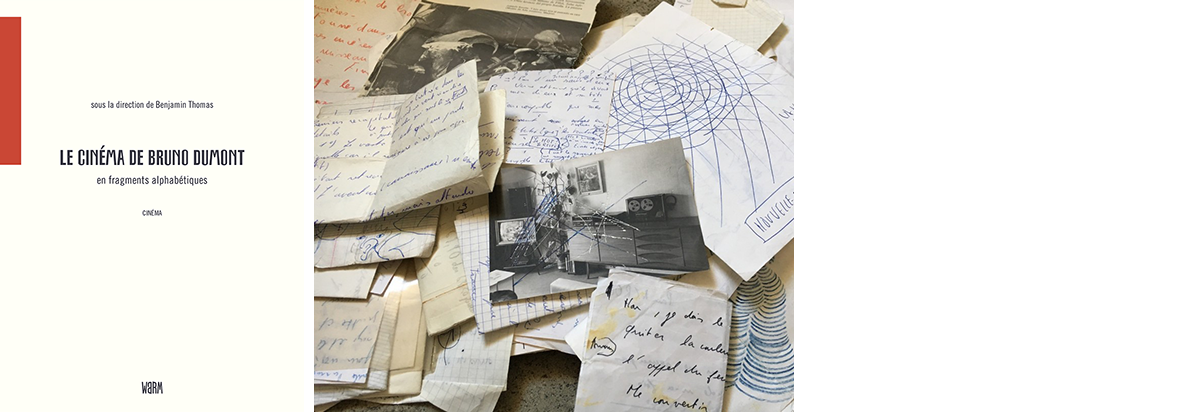
Following their books on Wang Bing and Lisandro Alonso, publishing house WARM now comes with a book on the work of the French filmmaker Bruno Dumont. Le cinéma de Bruno Dumont en fragments alphabétiques is a collective reflection in the form of 67 alphabetical fragments – from ‘Acteurs’ to ‘Zombies & cannibales’, passing ‘Bresson’, ‘Bruegel’, ‘Écriture’, ‘Espace’, ‘Giotto’, ‘Interstices’, ‘Paysages’, ‘Politique’, ‘Raccord’ or ‘Van der Weyden Rogier’ (see the full index on their website). With 28 contributors and devoted to his feature films, series as well as its heady motifs and questions, this book offers many possible entries in the thinking and cinema of Bruno Dumont. Meanwhile, the team of the online film journal Desistfilm has successfully initiated their first editorial project, dedicated to the French filmmaker, musician and “artiste total”, Marc Hurtado. The book Marc Hurtado: De Coeur à Coeur (working title) will contain over 25 essays, letters and poems on the full spectrum of his art, written by different international artists, critics, poets and musicians, including Nicole Brenez, F.J. Ossang and Lydia Lunch. They've started putting the book together in May; you can follow the project on their crowdfunding page.
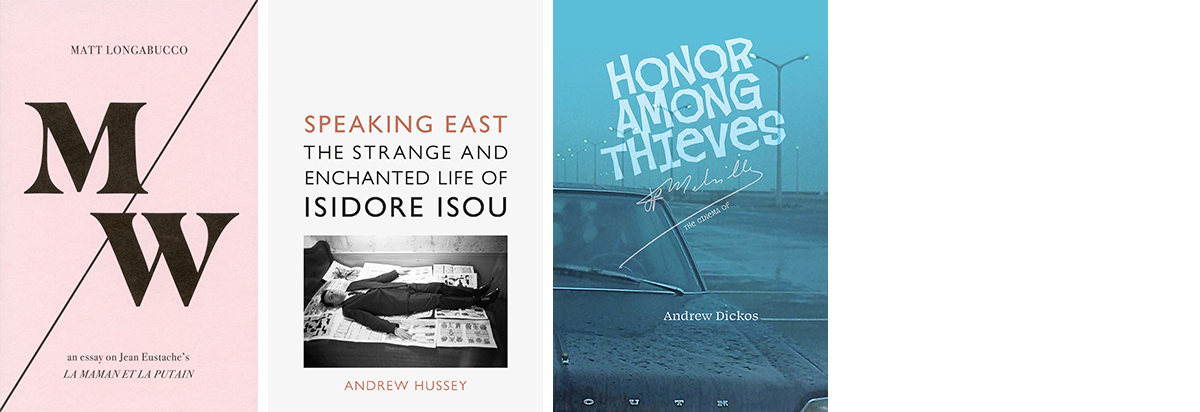
The last three monographs on French filmmakers or films we’ve singled out are written in English. M/W: An essay on Jean Eustache’s La Maman et la Putain is a book-length essay by poet and professor Matt Longabucco that reckons with Eustache’s document of political bitterness and romantic catastrophe from the standpoint of our own vexed present in which the unfulfilled legacies of the Left and the sexual revolution still haunt our hopes and darken our horizons. Published last May, the book’s available through the website of Brooklyn-based publisher Ugly Duckling Presse, where you can also read an excerpt. Forthcoming in September with Reaktion Books, Speaking East: The Strange and Enchanted Life of Isidore Isou is a new, English-language biography of Isidore Isou, who founded the avant-garde movement Lettrism. Andrew Hussey presents a vibrant account of both the life of a pivotal figure in the history of modern art and the sensuous cultural scene of postwar Left Bank Paris. Similarly, in Honor Among Thieves: The Cinema of Jean-Pierre Melville,film writer Andrew Dickos profiles the filmmakers’ life but also perceives him as an ethnographer of an unconventional sort in the way his movies present a sort of cartography of the rhythms and textures of Paris circa 1950s through the early 70s, as Ruairí McCann writes in his review. The book can be purchased on the website of publisher Contra Mundum Press, where you’ll find an excerpt and the table of contents.
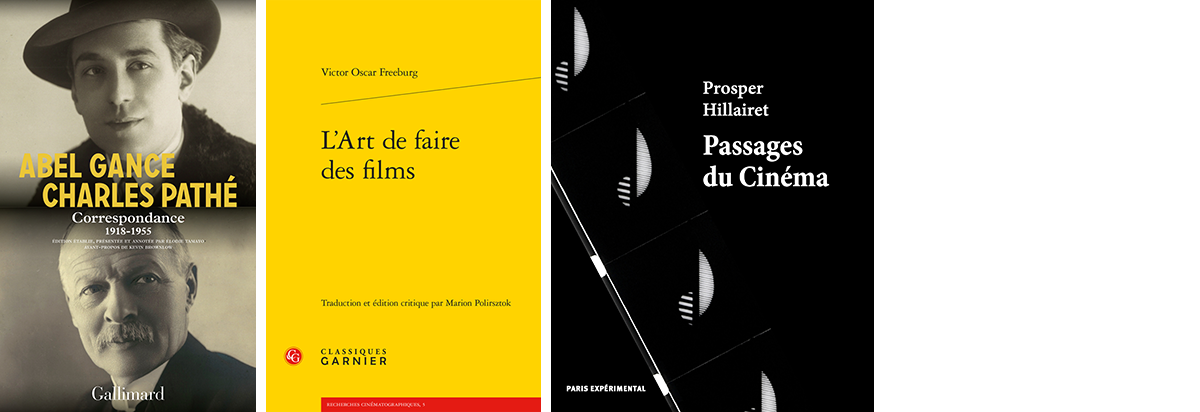
Another cluster of books looks towards the future of the medium as seen from the viewpoint of the late 1910s and 1920s. Published last month by Gallimard, Abel Gance/Charles Pathé: Correspondance, 1918-1955 brings together the 210 unpublished letters exchanged by two seemingly opposed figures, the avant-gardist Gance and industrialist Pathé who maintained a singular and rich relationship for nearly forty years. Prefaced by film historian and Gance expert Kevin Brownlow, this collection shows that their thinking about cinema and correspondence mirror the challenges of its time. Published in the same year the exchanges between Gance and Pathé began, Victor Oscar Freeburg’s pioneering 1918 book, The Art of Photoplay Making, has been translated for the first time in a French edition out with Classiques Garnier. Derived from Freeburg’s teaching at Columbia University, L’Art de faire des films offers an artistic pedagogy of cinema and examines the possibilities for the new medium to become an art. In Passages du cinéma, filmmaker and film historian Prosper Hillairet also starts from his texts on the avant-garde of the 1920s (Dalí, Dulac, Epstein, L’Herbier, ...) but equally turns to the French experimental filmmakers of the 70s and 80s (Jean-Claude Rousseau, Debord, Duras, Carax, ...) with some late forays into narrative cinema (Rohmer, Melville, Visconti, Fuller, Lynch, ...) and weaves a reflection on cinema as a visual form only to let passages occur between films, styles, filmmakers and eras. Out with Paris Expérimental, the publishing house he co-founded, this volume collects Hillairet’s articles from different magazines and programs, some are published for the first time.
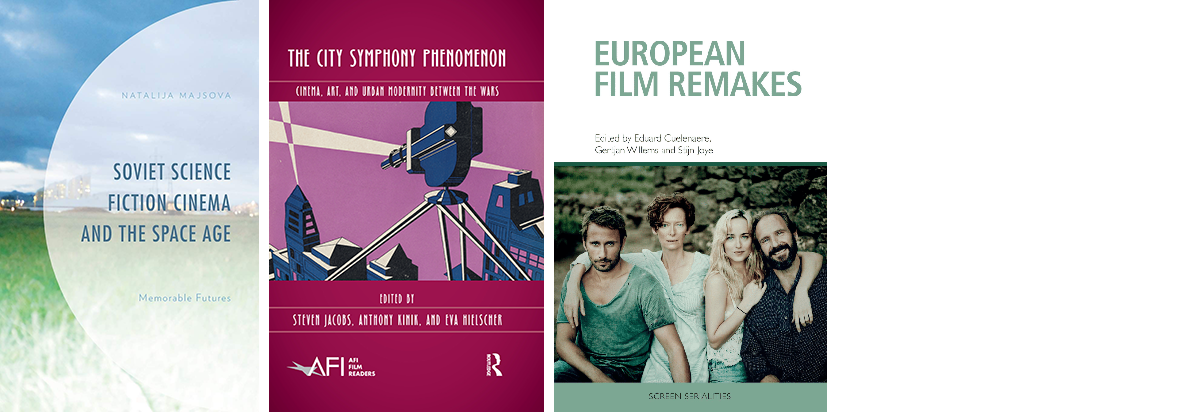
Let’s turn our attention to a number of new “Belgian” film publications. Natalija Majsova’s Soviet Science Fiction Cinema and the Space Age: Memorable Futures, published by Lexington Books, came about during a post-doc stay at the University of Antwerp and the Université catholique de Louvain (UCL). She offers an extensive and profound close reading of three dozen Soviet space films, ranging from science fiction blockbusters Aelita (1924) and Solaris (1972) to many less widely known films. The City Symphony Phenomenon: Cinema, Art and Urban Modernity Between the Wars – the book that Steven Jacobs & Eva Hielscher of the university of Ghent and Antwerp edited together with Anthony Kinik, and that was announced in a separate note on its initial 2018 relase – got a more affordable paperback edition last March. Edited by Eduard Cuelenaere, Gertjan Willems and Stijn Joye, all connected to the University of Ghent, the new collection European Film Remakes, out with Edinburgh University Press,moves away from the established tendency to focus on the Hollywood remake and discusses the mechanisms and singularities of this practice in a European context.
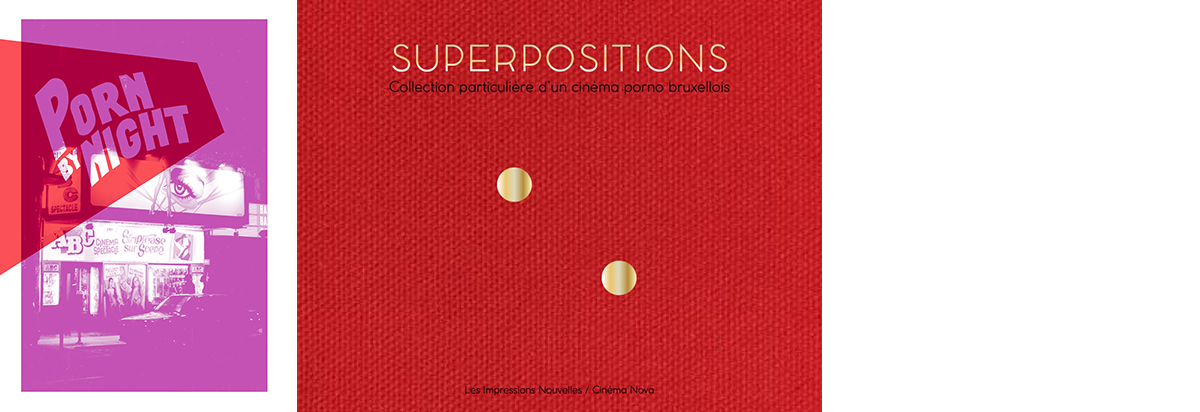
After the publication of Cinéma ABC: La nécropole du porno, announced in our fall 2020 book note, the ‘Centre de Recherche en Cinéma et Arts du Spectacle Vivant’ (CiASP) of the Université Libre de Bruxelles (ULB) also dug into the archives of the closed down Brussels porn theater that are preserved by Cinema Nova. Published in the framework of a doctoral seminar, Porn by Night presents the outcome of their interdisciplinary research. Coordinated by Muriel Andrin and Karel Vanhaesebrouck, the publication is available to download for free; a paper copy can be demanded through CiASP. Based on the same ABC archives, a team of Cinema Nova explored through a hundred publicitary porn photographs (selected out of a thousand) the inventive practices of hiding and accentuating the nude parts that couldn’t be displayed in the show windows of the movie theater, using felt-tip pens, dots and all kinds of stickering as a plastic and imaginative way of censoring. Published by Nova and Les Impressions Nouvelles, Superpositions: Collection particulière d’un cinéma porno bruxellois also includes a number of texts with reflections and information, and has an own website where you can find how to get the book.
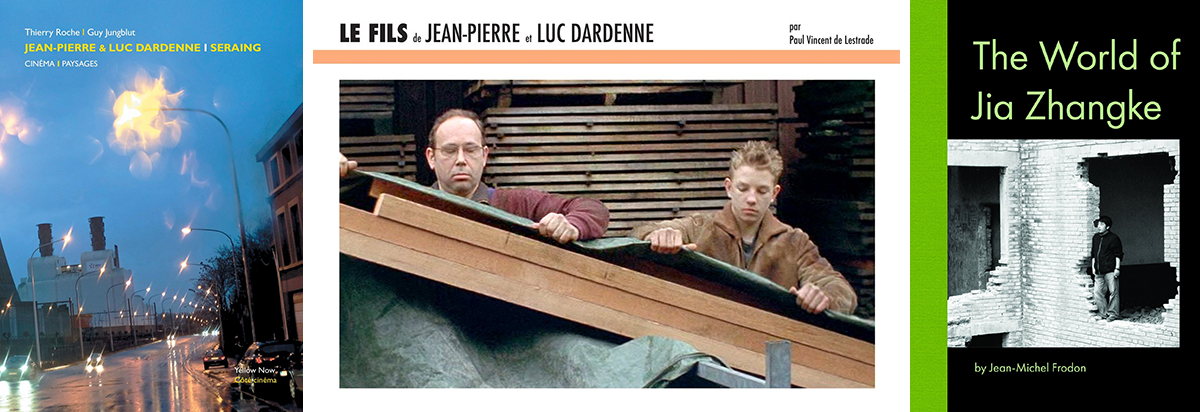
The Belgian publishing house Yellow Now comes with a pair of publications on the Dardenne brothers. The second volume in their ‘Paysages’ series on a specific city and mode of writing, Jean-Pierre et Luc Dardenne / Seraing is based on three successive stays in Seraing – the Walloon town where the Dardennes shot almost all of their films – in the company of Guy Jungblut, who took photographs that frame and fuel the writing. Not merely illustrations, the photographic sequences constitute an independent look at the city, its peculiarities and its faults, but are at the same time connected to the ways of filming of the Dardenne brothers, such as the incessant movements of the characters, their gestures, their relationship to the world of work and to speech. Next month, Yellow Now will also release a new book on the Dardennes’ Le fils (2002) in another one of their series, the beautiful collection ‘Long métrage’ which each time is devoted to one film. The book focuses on the cinematographic ethics and, through it, the conception of a certain humanity and world that the film embodies. At the end of the publication an interview is included with Jean-Pierre Duret, the sound engineer of Le fils and the majority of their films. While at Editions Yellow Now, let’s take note that their original 2016 edition of Jean-Michel Frodon’s Le monde de Jia Zhang-ke has been translated into English by none other than Sally Shafto and prefaced by Dudley Andrew. The World of Jia Zhang-ke – a comprehensive look at his work, combined with essays on each of his films and an extensive in-depth interview with Jia and his main collaborators – will be released at the end of next month by Film Desk Books.
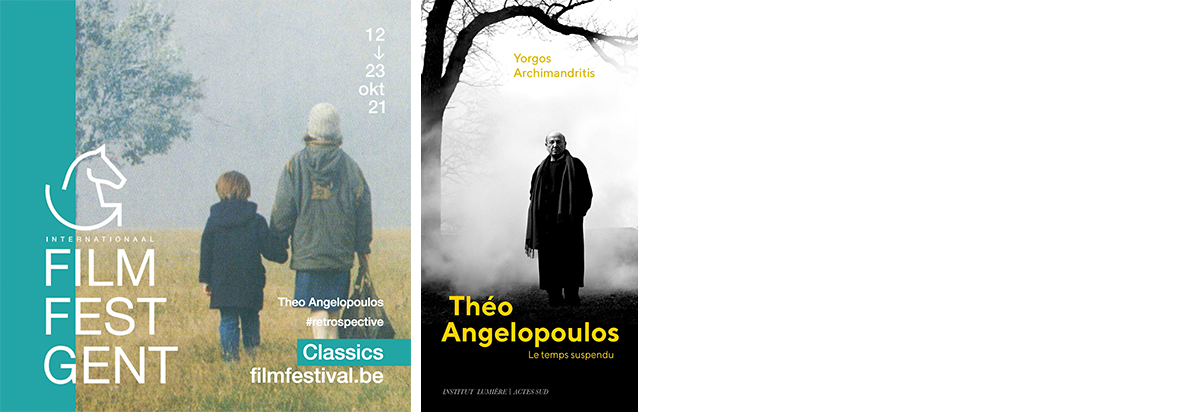
Film Fest Gent released a free, Dutch-language publication on Theo Angelopoulos for their upcoming full retrospective of the work of the Greek filmmaker in October. The author and curator of the retrospective, Patrick Duynslaegher, wrote a contextual piece on Angelopoulos and his work, and the booklet also includes a short text on each film and a timeline of modern Greek history. In May, Yorgos Archimandritis also collected his conversations with Angelopoulos that were broadcasted on France Culture in 2009 and are now published for the first time by Actes Sud and Institut Lumière. In Théo Angelopoulos: Le temps suspendu, the director talks about his childhood, his discovery of poetry before that of cinema, the coup of the colonels in Greece, his exile in France as a student, and his relationship to travelling and the process of filmmaking.

A lot has been moving in the field of film magazines as well. News hit that Trafic is folding. Issue 120 (Winter 2021), devoted to the theme “The Things We Love Well, Remain ...” would be the final one, although the magazine, founded by Jean-Claude Biette and Serge Daney in 1991, might metamorphose into a new annual publication. Contrarily, two other journals have been relaunched last March. Following a months-long hiatus, Film Comment returned in the form of a free weekly digital Film Comment Letter, announced as “a first step” in bringing back its original film criticism and writing. The journal Jump Cut, which has been publishing since 1974, also relaunched with a new, sixtieth issue (Spring 2021), which is the first since 2019. Meanwhile, two magazines celebrated an anniversary last April. While they released a call for support in Spring, De Filmkrantcelebrated its 40th anniversary with a special issue, not in their usual tabloid format but as a 100-page book. You can download this XL edition for free or order it on their website. Cahiers du cinéma celebrated its 70th birthday with its April issue, and has started to share and roll out more pieces online on their website. For that matter, Daniel Fairfax has written a historical overview of a specific period in the journal’s history: its militant turn under editors-in-chief Jean-Louis Comolli and Jean Narboni. The Red Years of Cahiers du cinéma (1968-1973) combines biographical accounts of the critics who were involved with Cahiers in the post-1968 period with theoretical explorations of the texts they wrote. Forthcoming in September in two volumes, ‘Ideology and Politics’ and ‘Aesthetics and Ontology’ respectively, this high-priced 880-page book can be pre-ordered on the website of publisher Amsterdam University Press, where you can also find the full table of contents.
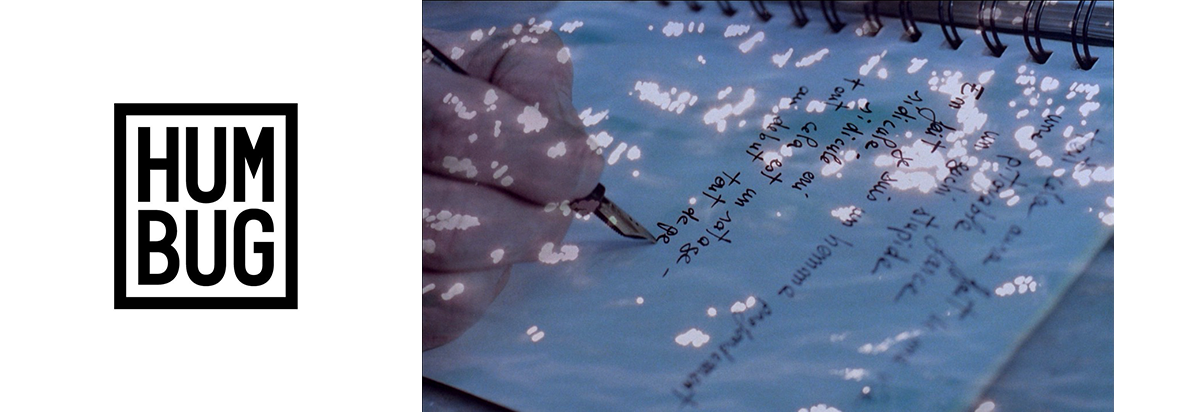
In Belgium, we’re in the peculiar situation of two newly-founded Flemish film magazines; both publish the inaugural print issue of their quarterly in October. Last month, Humbug launched online and the first paper edition will follow this fall. The editorial team consists of Johannes De Breuker (Knack Focus), Ruben Aerts (De Standaard) and Fien Meynendonckx, with Emma Geets as illustrator and graphic designer. Fantômas has been granted with the state funding that remained unassigned after the discontinuation of Filmmagie (1956-2020), reported in our previous book note and in a separate state of affairs. Fantômas will launch as an online magazine in September and the next month in print. Its team of editors is formed by Bjorn Gabriels (former editor-in-chief of Filmmagie), Bart Versteirt (CINEA/Photogénie) and freelance critic Inge Coolsaet. They’ve send out their first newsletter this month.
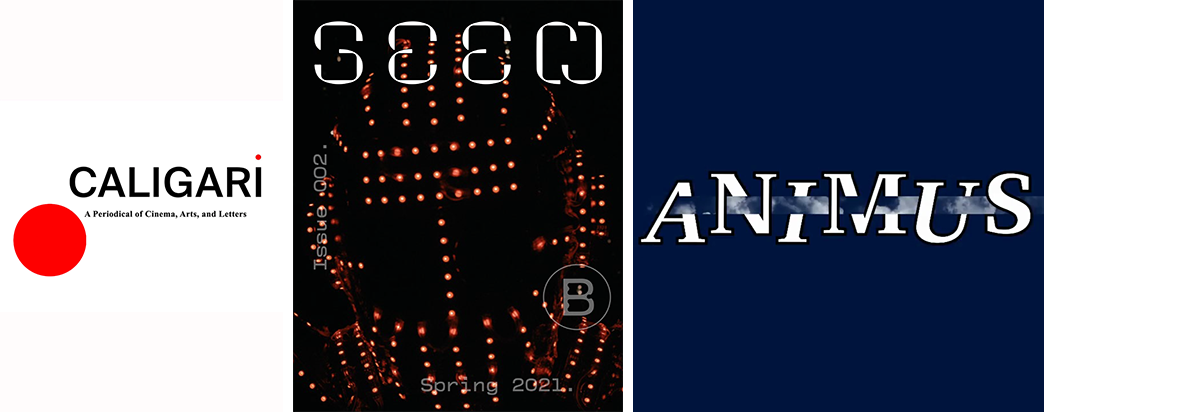
Internationally, three more new (online) film journals were founded. April 1 saw the release of the first issue of Caligari: A Periodical of Cinema, Arts, and Letters. It features an interview with John Akomfrah by Devika Girish, but also the English version of Olivier Assayas’ 2020 State of Cinema for Sabzian, and much more. This mixed-genre online journal will be published quarterly from Los Angeles. At the end of last year, BlackStar Film Festival in Philadelphia launched its new online and print magazine Seen, “a twice-annual journal of film and visual culture made for and about Black, Brown, Indigenous and other artists of colour.” The inaugural issue includes a piece on the importance of William Greaves and a review of Sky Hopinka’s latest film, among many other articles. The second issue just dropped last month. Also in June, the new London-based online film magazine Animus was created by critic Elena Lazic out of a frustration about the state of film criticism in the U.K. New issues are published monthly, each featuring six essays. You can read the June and July editions and support their Patreon.
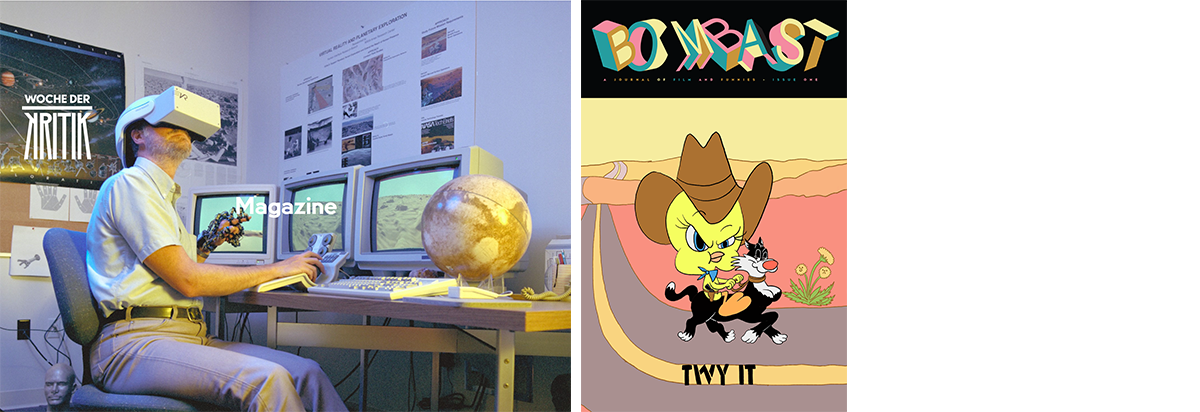
Last March, Woche der Kritik/Berlin Critics’ Week also launched a magazine, edited by Film Comment’s former editor-in-chief Nicolas Rapold. The Critics’ Week is an annual independent and open space for debate during the Berlinale festival with Dennis Vetter as its artistic director. Featuring many texts reflecting on the state of film criticism, the magazine includes contributions by Ela Bittencourt, Becca Voelcker, Victor Guimarães, Nick Pinkerton and many others. In May, Nick Pinkerton launched his own magazine. Featuring artwork and texts, Bombast #1: A Journal of Film and Funnies is a full-color publication of some 75 pages. The texts are mostly conversations, none previously published elsewhere: a penultimate interview with Budd Boetticher conducted in 2000, a 2017 interview with Wang Bing by Pinkerton, a conversation between him and cinematographer Sean Price Williams on the late films of Blake Edwards, and a script prospectus for Pinkerton's own film project. The zine was first available for paid subscribers of Pinkerton’s Substack Employee Picks. You can still order the issue via publisher the Beacon Cinema. The first printing has sold out in June and the second printing is in the works. They aim to publish an new issue of Bombast twice a year.
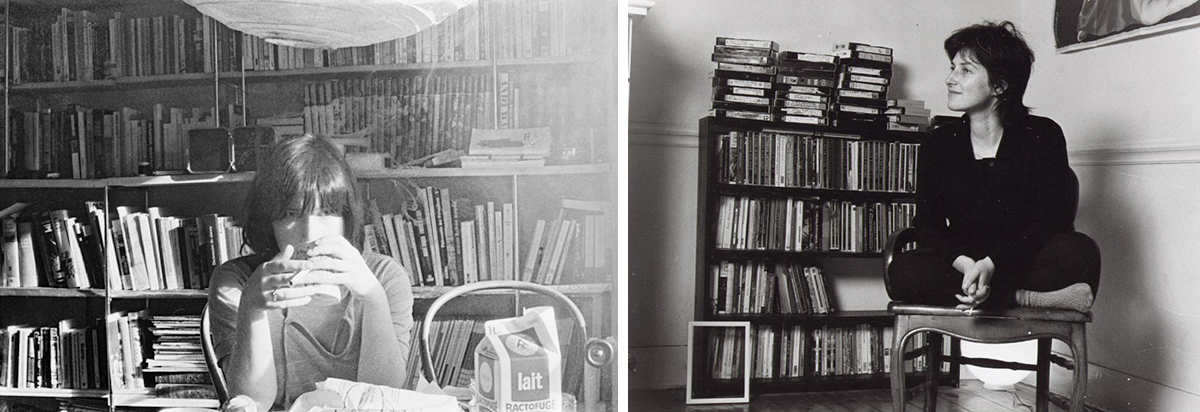
Let us conclude with some future book projects to look forward to. In 2022, L’Arachnéen will publish the writings of Chantal Akerman (about 1500 pages), edited by Cyril Béghin. And the English translation of Serge Daney’s La maison cinéma et le monde: Vol 1, announced in our previous book note, now has a website and a date: February 2022. In the meantime, you can catch up with Laurent Kretzschmar and Srikanth Srinivasan’s translations of Daney’s full Libération coverage of the 1984 Cannes Film Festival that they’ve published in real time last May if you haven’t already done so.

